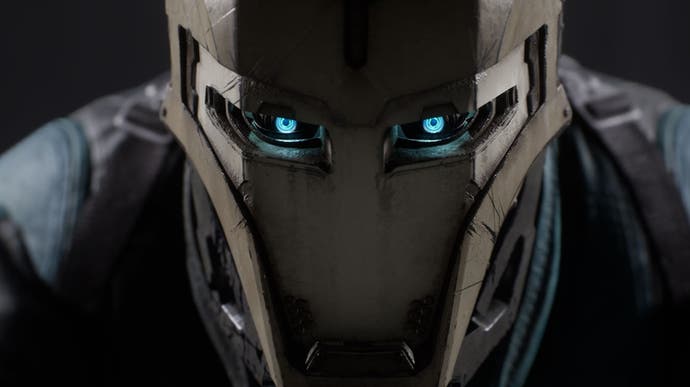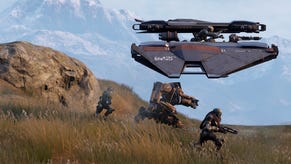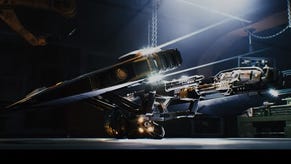Disintegration review - a quirky but troubled sci-fi shooter
Ah shucks.
Back at last year's E3 - an event that now feels like a lifetime ago - I had a chat with V1 founder Marcus Lehto to pin down what Disintegration was all about. Due to the game's dystopian sci-fi setting and Lehto's background as the co-creator of Halo, I came away thinking Disintegration's narrative had the potential to explore some fascinating topics, including post-humanism and the threats to our world today.
In the end, Disintegration doesn't ever delve too far into these ideas: but what I didn't expect was a silly yet genuinely convincing shooter hidden beneath the surface.
Disintegration bills itself as a first-person shooter with real-time strategy elements, half campaign and half multiplayer, set in a future version of Earth ravaged by every bad thing under the sun. Climate change, pandemic, war - all things so alien to us here in 2020... The premise is that swathes of the Earth's population have chosen to "integrate" in order to survive the harsh conditions: a process of transplanting someone's brain into a robot body to preserve their consciousness. It was intended to be a temporary measure, but a nefarious group called the Rayonne decided integration was actually the future of humanity. The motives for which aren't really established at the start of the campaign, unfortunately, but at least you can tell they're bad guys from their glowing red eyes. As Romer Shoal - a celebrity who previously convinced people to integrate - you and your band of robot outlaws team up to take down the Rayonne using a combination of your Gravcycle (a weaponised hoverbike) and ground units, each of whom boast special abilities and can be commanded to attack specific enemies.

Disintegration's story blurs into a jumble of missions, but the levels are such a romp that I didn't really care about the narrative reasons for being there - I just knew I was having a good time. Each one introduces new challenges, with varying team compositions, Gravcycle weapons and enemy types which force you to reconsider and evolve your tactics. Thanks to the hybrid nature of the combat, you can opt to just shoot your way out of trouble, but the secret to success is managing battles through the RTS mechanics. It's about knowing your enemies, and which ones to prioritise. I soon discovered aerial units and snipers could easily destroy my Gravcyle, which was also hard to heal and would instantly fail the mission if blown up. I started commanding my troops to prioritise those units first, and later learned how to manipulate the Gravcycle's mobility to swoop behind cover. It's easy to be overwhelmed during the chaos of these battles, and sometimes the best approach is to methodically pick off enemies while keeping your Gravcycle distant, rather than flying in guns blazing. As I learned to my peril.
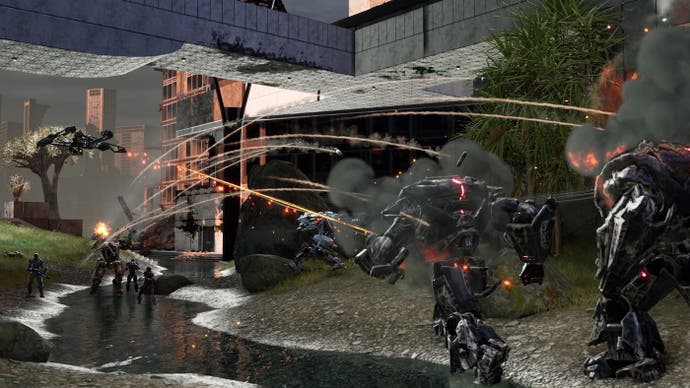
Some of the main tools in your arsenal are unit abilities, and these are deeply satisfying when used to good effect: landing a mortar barrage on a bunched-up group of enemies results in a satisfying crunch of robot bodies, while a time-slowing dome creates a shimmering Matrix moment amidst the disorder. Adding to the chaos is the destructibility of the surroundings, which shatter and explode across the screen. It's not just about cool explosions, however, as destroying enemy cover will make it far easier for your team to get a clean shot.
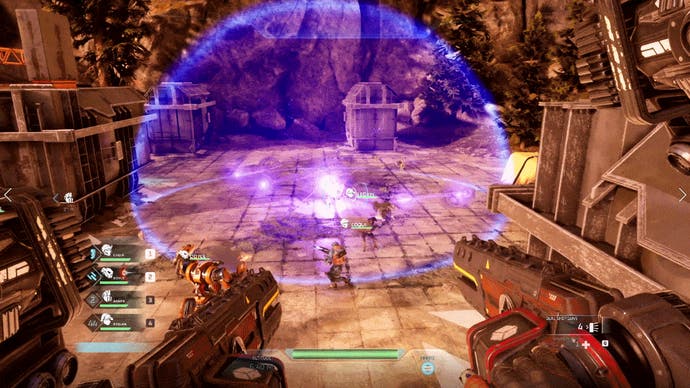
The level design in Disintegration's campaign forces significant changes in gameplay style more broadly, some areas requiring the player to ferret enemies out of hollow brutalist buildings, others providing life-saving refuge in the midst of a heavy aerial battles. One tense rescue mission requires precision flying and sneaking around in tight spaces - without backup from your team - armed only with sticky grenades. Another sees you shepherd your team between protective domes, or risk being stunned by an EMP pulse mid-battle. And there's just something rather lovely about the use of scale and perspective in these levels. One of the earliest sees you fight amongst ruined wooden houses and a graveyard, like directing toy soldiers between doll houses. Later in the mission, you skim over vast golden plains to explore the wreckage of a vast, burnt-out spaceship which dwarfs you and your crew. There's storytelling within the levels that feels enjoyably dramatic in a Call-of-Duty way, with my personal favourite mission seeing the outlaws ascend grassy hills to fight a climactic battle atop a dam. Despite the world feeling desolate and barren, I kept wanting to explore and admire the gorgeous North American landscapes.
It's hardly a narrative masterpiece, but Disintegration's campaign is about putting a new spin on the classic sci-fi shooter... and letting rip on waves upon waves of robots. The mechanics alone are novel enough to keep you entertained, and once the ability to multi-task the FPS and RTS elements clicks, there's plenty of room to keep refining your techniques. Once I'd finished the campaign, I went back to replay levels on a higher difficulty with my new-found knowledge, and found myself thinking more carefully about timing my special abilities, and how to smoothly manoeuvre the Gravcycle through levels. In short, it not only entertained me for the nine hour campaign, but kept me coming back.
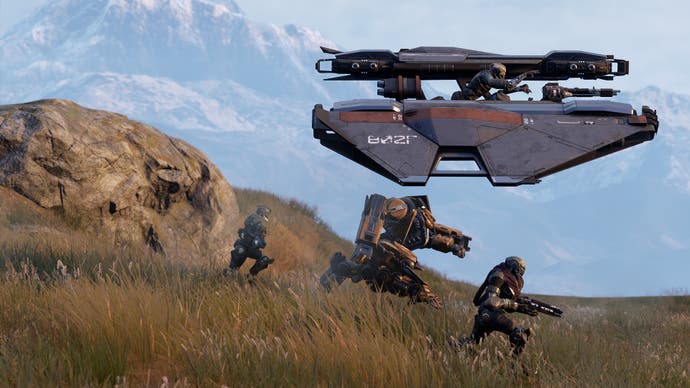
The multiplayer is, unfortunately, where all this good work comes unstuck. I played a brief two-hour session before Disintegration's release, but I wanted to test the multiplayer in public matches before writing this review. After three days of trying, I have been unable to connect to a match on PC. Judging by comments left on Steam and Twitter, I'm not alone in experiencing this, although I cannot say whether the problem lies with a technical issue or a simple lack of players.
It's a shame, because I felt I'd only just scraped the surface of Disintegration's multiplayer experience. It's a team-based shooter, kind of like Overwatch if everyone played Pharah. You can pick between nine different Gravcycle crews, all with different perks, strengths and specialities, in three different game modes: Zone Control (capturing zones), Collection (basically team deathmatch with tags), and Retrieval (attack/defence). The modes themselves are fairly standard stuff, but the complexity comes from the ground units, team composition, and maneuvering your Gravcycle. In the first few matches, I initially focused my attention on enemy Gravcycles - which you would, seeing as they're the enemy player. Yet that's only half the story, as the ground units are often essential in completing each mode's objectives. In Collection, for instance, points can be gained from killing enemy ground units rather than just other Gravcycles, and it makes more sense to target these as they're much easier to kill - and there are simply more of them. In Retrieval, only your ground units can carry the core to the drop-off point.
I tried flitting between a few different crews to get a feel for them, and went with the obvious tactic of choosing faster crews for attack, and tankier Gravcycles for defence, but I found some of the lighter crews would simply crumble into dust when put under any kind of pressure, and the increased maneuverability wasn't enough to balance it out. I enjoyed experimenting with the different abilities for each crew, but in the end I found myself favouring high-damage crews like The Ronan to keep up with the carnage. Or maybe that's just my playstyle - dumping a load of rockets on a fellow journalist's Gravcycle is quite fun, what can I say?
There were moments in the demo session where I felt the team genuinely start to pull together: people were healing each other, moving as a group to target weaker Gravcycles, and setting up proper defences on zones using proximity mines. To Disintegration's credit, the multiplayer did make me want to improve. The battles are frantic and not immediately readable to new players, and I imagine there's a fairly high skill ceiling. This might be where the problem lies, as the multiplayer doesn't instantly grab you, but becomes more interesting over time.
In the end, of course, I wasn't able to spend more time with the multiplayer - and it's disappointing, because Disintegration's campaign gameplay is so compelling that I would happily recommend it to anyone who asked. Yet it's hard to justify a £39.99 price tag when half of the game is, for many, currently unusable. I also fear Disintegration's realistic art style and gritty sci-fi setting makes it appear run-of-the-mill, when its gameplay actually has quite a lot to offer. This might be a case of holding off until later (or perhaps until V1 makes the multiplayer free-to-play), but if you do decide to take the plunge on Disintegration, I can guarantee you one thing: somehow, inexplicably, you will never get tired of smashing robots.
